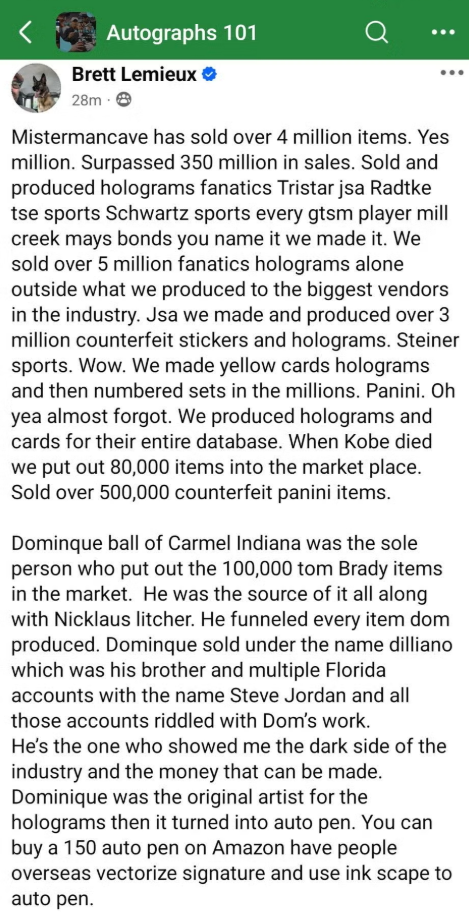
In a twist worthy of a gripping sports drama, the world of sports memorabilia has encountered its own scandalous moment of infamy. Enter stage right: a seemingly regular guy named Brett Lemieux, an autograph dealer whose unfathomable actions have left the sports collectibles community reeling. According to Indiana authorities, this purveyor of memorabilia wasn’t just selling keepsakes; he was allegedly masterminding a counterfeit operation so audacious it would make a con artist proud. His sudden death, by apparent suicide during a police raid, adds yet another layer to this tangled tale.
On the surface, the rise and fall of Brett Lemieux, age 45, reads like a gripping whodunit. Authorities in Westfield, Indiana had Lemieux in their sights as they honed in on a massive counterfeit memorabilia scheme. As officers executed a search warrant—what should have been the climax of a long investigation—the plot took an unexpected turn with the discovery of Lemieux’s body, the coroner yet to confirm, but police suggest, a suicide via gunshot.
The scope of the alleged fraud, stretching potentially into the hundreds of millions of dollars, has rocked the very foundations on which the memorabilia market stands. Lemieux’s startling post in the “Autographs 101” Facebook group—a virtual confession to orchestrating a counterfeit ring that churned out over four million fake items—sent shockwaves through collector circles. Not only did it throw into question the legitimacy of countless collections, it spotlighted the tenuous relation between trust and authenticity in this niche market.
Under the guise of Mister Mancave, Lemieux purportedly curated “the largest framed jersey inventory on the web.” His enterprise lacked a brick-and-mortar presence, despite claiming a Columbus, Ohio address. Yet, records show its incorporation in Indiana, a locus of his alleged activities. Lemieux’s confession outlined a forgery practice that included duplicating the very hologram stickers used by authentication powerhouses like Panini and Fanatics, among others. His audacity is typified in his exploits following the tragic passing of Kobe Bryant, a moment when the saga of his September-released 80,000 counterfeit items took a morbid turn.
This scandal isn’t confined to basketball; it crosses the diamond too, exemplified by a scandalous listing for an Aaron Judge-signed baseball that flaunted a faux Fanatics hologram at a too-good-to-be-true price. The reality check for the industry transpired as such dubious deals, unbeknownst to the public, undercut legitimate autograph vendors—all hidden under the veil of expertly forged verification measures.
In an attempt to steer the ship through the storm, industry leaders try patching up a now-fractured veneer of trust. Fanatics, a linchpin in memorabilia authentication, has reportedly bolstered its hologram technologies and remains in close quarters with law enforcement and forensic sleuths of counterfeit artifacts, including seasoned ex-FBI agents.
Lemieux’s claims, particularly the astronomical figure of $350 million in fake market sales, are controversial. Wife-tales or not, the tangible damage is undeniable. With autopen machines and other deceptive instruments in play, as authenticity expert Steve Grad illuminates, discerning the real from the forgery has become a Herculean task for collectors and professionals alike.
Yet, for some market insiders, the revelation of such a scheme was less a surprise and more an affirmation of suspicions. The appearance of autographs from reclusive athletes even led a few industry mavens to peer askance, indicating, in their view, signs of anomalous activities were looming.
Names like Dominique Ball of Indiana and Nickolas Litscher of Wisconsin surfaced amid controversy stirred by Lemieux’s parting exposé. Both men have refuted any inkling of involvement, with Litscher gearing up to take up cudgels against such allegations through legal routes.
The repercussions of this scandal trickle down to the core of the memorabilia market, urging collectors to scrutinize what’s known and what’s touted. The exposed counterfeit operation, sprawling across business facades like Ultimate Sports and Athletes One, makes clear the necessity for vigilance and robust fraud detection measures.
Collectors, once confident in their showroom shelves, now dissect their collections with a wary eye. The scandal may serve as a clarion call, drawing the industry’s attention to a future where the battle against sophisticated forgery is ever-enduring. As the dust settles, the market braces for a return to equilibrium, emboldened against deceit, one genuine, certified autograph at a time.
